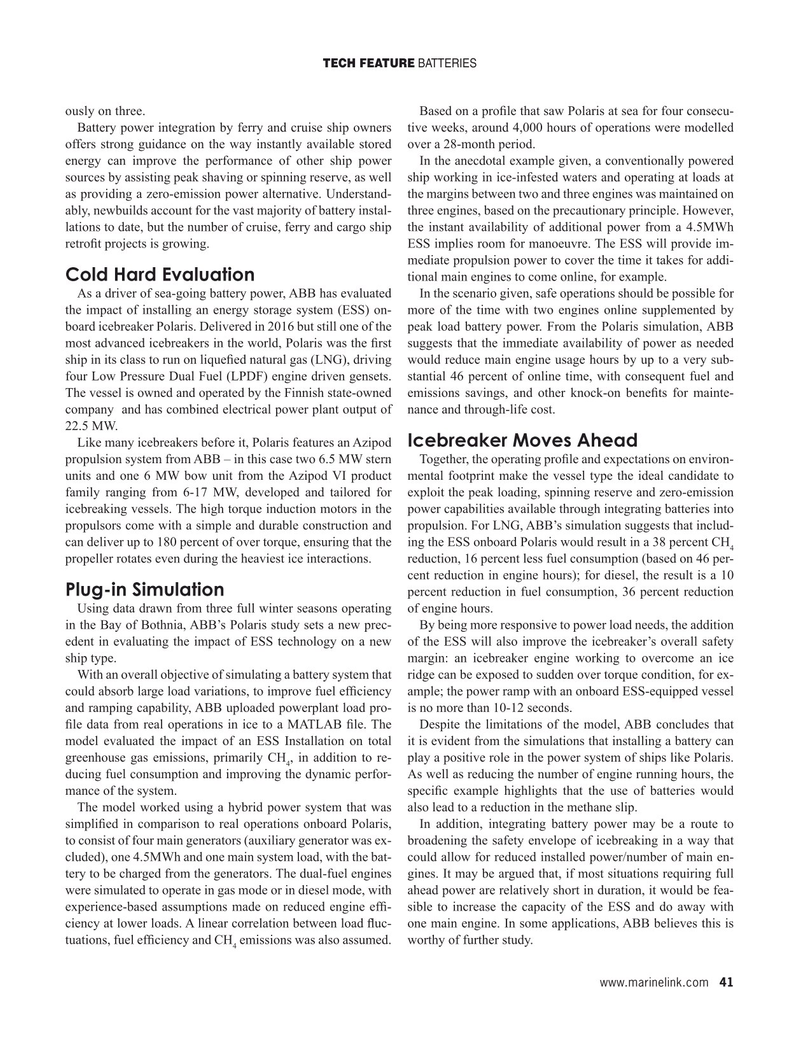
Page 41: of Maritime Reporter Magazine (June 2023)
The Digital Ship
Read this page in Pdf, Flash or Html5 edition of June 2023 Maritime Reporter Magazine
TECH FEATURE BATTERIES ously on three. Based on a pro? le that saw Polaris at sea for four consecu-
Battery power integration by ferry and cruise ship owners tive weeks, around 4,000 hours of operations were modelled offers strong guidance on the way instantly available stored over a 28-month period. energy can improve the performance of other ship power In the anecdotal example given, a conventionally powered sources by assisting peak shaving or spinning reserve, as well ship working in ice-infested waters and operating at loads at as providing a zero-emission power alternative. Understand- the margins between two and three engines was maintained on ably, newbuilds account for the vast majority of battery instal- three engines, based on the precautionary principle. However, lations to date, but the number of cruise, ferry and cargo ship the instant availability of additional power from a 4.5MWh retro? t projects is growing. ESS implies room for manoeuvre. The ESS will provide im- mediate propulsion power to cover the time it takes for addi-
Cold Hard Evaluation tional main engines to come online, for example.
As a driver of sea-going battery power, ABB has evaluated In the scenario given, safe operations should be possible for the impact of installing an energy storage system (ESS) on- more of the time with two engines online supplemented by board icebreaker Polaris. Delivered in 2016 but still one of the peak load battery power. From the Polaris simulation, ABB most advanced icebreakers in the world, Polaris was the ? rst suggests that the immediate availability of power as needed ship in its class to run on lique? ed natural gas (LNG), driving would reduce main engine usage hours by up to a very sub- four Low Pressure Dual Fuel (LPDF) engine driven gensets. stantial 46 percent of online time, with consequent fuel and
The vessel is owned and operated by the Finnish state-owned emissions savings, and other knock-on bene? ts for mainte- company and has combined electrical power plant output of nance and through-life cost. 22.5 MW.
Like many icebreakers before it, Polaris features an Azipod Icebreaker Moves Ahead propulsion system from ABB – in this case two 6.5 MW stern Together, the operating pro? le and expectations on environ- units and one 6 MW bow unit from the Azipod VI product mental footprint make the vessel type the ideal candidate to family ranging from 6-17 MW, developed and tailored for exploit the peak loading, spinning reserve and zero-emission icebreaking vessels. The high torque induction motors in the power capabilities available through integrating batteries into propulsors come with a simple and durable construction and propulsion. For LNG, ABB’s simulation suggests that includ- can deliver up to 180 percent of over torque, ensuring that the ing the ESS onboard Polaris would result in a 38 percent CH 4 propeller rotates even during the heaviest ice interactions. reduction, 16 percent less fuel consumption (based on 46 per- cent reduction in engine hours); for diesel, the result is a 10 percent reduction in fuel consumption, 36 percent reduction
Plug-in Simulation
Using data drawn from three full winter seasons operating of engine hours.
in the Bay of Bothnia, ABB’s Polaris study sets a new prec- By being more responsive to power load needs, the addition edent in evaluating the impact of ESS technology on a new of the ESS will also improve the icebreaker’s overall safety ship type. margin: an icebreaker engine working to overcome an ice
With an overall objective of simulating a battery system that ridge can be exposed to sudden over torque condition, for ex- could absorb large load variations, to improve fuel ef? ciency ample; the power ramp with an onboard ESS-equipped vessel and ramping capability, ABB uploaded powerplant load pro- is no more than 10-12 seconds. ? le data from real operations in ice to a MATLAB ? le. The Despite the limitations of the model, ABB concludes that model evaluated the impact of an ESS Installation on total it is evident from the simulations that installing a battery can greenhouse gas emissions, primarily CH , in addition to re- play a positive role in the power system of ships like Polaris. 4 ducing fuel consumption and improving the dynamic perfor- As well as reducing the number of engine running hours, the mance of the system. speci? c example highlights that the use of batteries would
The model worked using a hybrid power system that was also lead to a reduction in the methane slip. simpli? ed in comparison to real operations onboard Polaris, In addition, integrating battery power may be a route to to consist of four main generators (auxiliary generator was ex- broadening the safety envelope of icebreaking in a way that cluded), one 4.5MWh and one main system load, with the bat- could allow for reduced installed power/number of main en- tery to be charged from the generators. The dual-fuel engines gines. It may be argued that, if most situations requiring full were simulated to operate in gas mode or in diesel mode, with ahead power are relatively short in duration, it would be fea- experience-based assumptions made on reduced engine ef? - sible to increase the capacity of the ESS and do away with ciency at lower loads. A linear correlation between load ? uc- one main engine. In some applications, ABB believes this is tuations, fuel ef? ciency and CH emissions was also assumed. worthy of further study.
4 www.marinelink.com 41
MR #6 (34-44).indd 41 6/5/2023 8:46:47 AM

 40
40

 42
42
